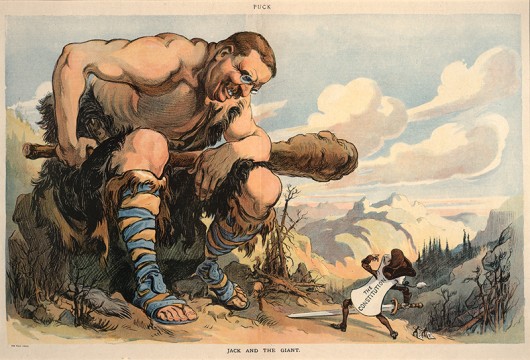
Joseph Keppler. “Jack and the Giant”. Puck, March 20, 1907. The Ohio State University, Billy Ireland Cartoon Library & Museum. Credit: Courtesy of Marilyn Scott
Ohio State’s Billy Ireland Cartoon Library and Museum offers visitors an artistic and humorous glimpse into 19th-century U.S. politics and communication during the turn of the century world war.
The museum, located in Sullivant Hall, will be showcase the exhibits “What Fools These Mortals Be! The Story of Puck” and “Seeing the Great War.” “The Story of Puck” features a collection of political cartoons from the 19th-century humor magazine Puck, while “Seeing the Great War” depicts the evolution of communication in America during World War I.
“The Story of Puck” highlights the library’s extensive collection of original issues of Puck, America’s first influential humor magazine published from 1877 to 1918. Decorated with editorial cartoons and political satire from cover to cover, Puck offers visitors an entertaining glimpse into 19th-century America, said Jenny Robb, curator and associate professor of the Billy Ireland Cartoon Library and Museum.
“I think it’s a fascinating way to look at a particular time period and what was going on during that time period and what issues were important — everything from presidential elections to some of the social issues that were being discussed at the time,” Robb said. “To look at those through the lens of these cartoons is really fun.”
Among some of the excerpts from Puck on display in the exhibit is a humorous cartoon from 1880 debating the pros and cons of women’s suffrage and several interesting cartoons centering on immigration, Robb said.
“(Immigration) is a very controversial issue in the United States, and this was the case over 100 years ago when these cartoons were published as well,” Robb said. “So some of the cartoons are about things that are a little bit more obscure or maybe some of the things that we don’t know that much about now, but some of the cartoons are about issues that we are still confronting today.”
Robb said visitors should appreciate the pieces for their historic and artistic value.
“I hope (visitors) agree that these are beautiful works of art,” Robb said. “The printing method that Puck pioneered was chromolithography. So for the first time they were able to print these cartoons in full color, and they’re really spectacular.”
“Seeing the Great War,” which features clothing from OSU’s Historic Costume and Textiles Collection and music and film materials from the Rare Books and Manuscripts Library, in addition to cartoons, focuses on communication and information management during World War I rather than chronological events, said Lucy Caswell, curator for “Seeing the Great War” and founding curator for The Billy Ireland Cartoon Library.
The exhibit looks closely at the workings of the Committee on Public Information, an independent government agency created to influence public opinion during World War I, Caswell said.
“Because the Committee on Public Information managed the voluntary censorship that was practiced after the U.S.A. entered the war in April 1918, the imagery across print genres — editorial cartoons, comic strips, posters — is very similar, and this reinforces the uniformity of how contemporary people viewed the conflict in Europe,” Caswell said in an email.
Caswell said the exhibit offers visitors the opportunity to observe the standardization of public opinion at the time of World War I relative to the diversity in opinions seen today.
“Information management is a current topic of much public debate,” she said. “I hope that visitors to the exhibit will reflect on the uniformity of public opinion during the First World War, which is a great contrast to the wide divisions in American public opinion today.”
“What Fools These Mortals Be! The Story of Puck” and “Seeing the Great War” will be on display in the Billy Ireland Cartoon Library and Museum in Sullivant Hall until Jan. 24. Admission is free.


